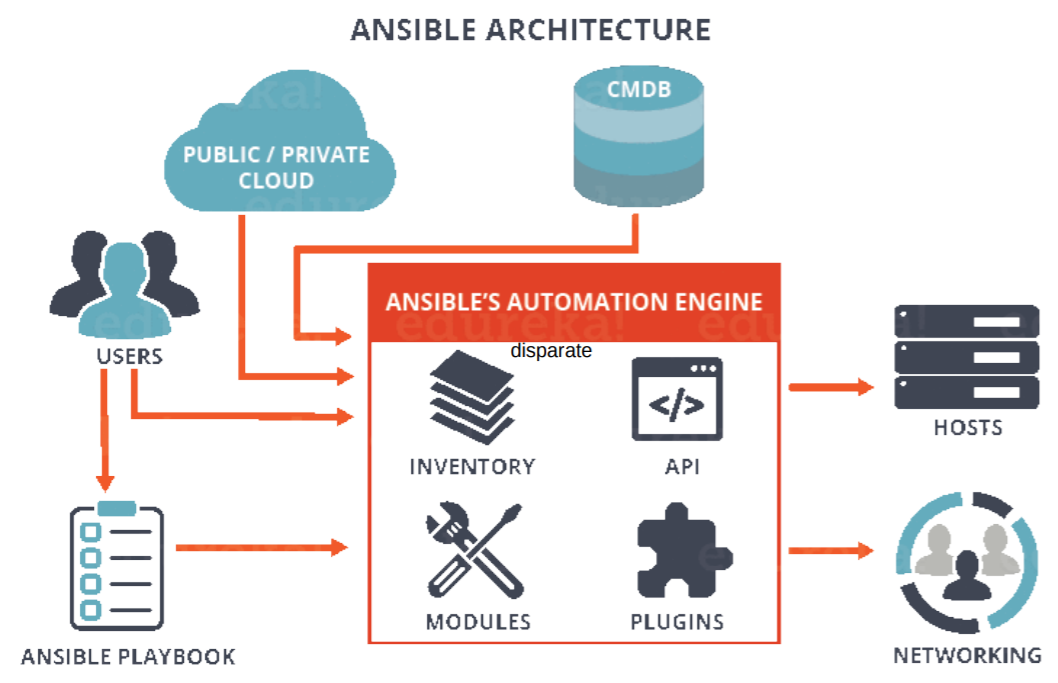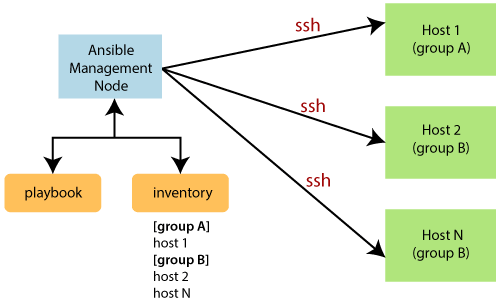Ansible – Introduction
-
Ansible is an open-source configuration management and provisioning tool, similar to Chef, Puppet or Salt.
-
It uses SSH to connect to servers and run the configured Tasks. Ansible lets you control and configure nodes from a single machine.
-
What makes it different from other management software is that Ansible uses SSH infrastructure. The project was founded in 2013 and bought by Red Hat in 2015
Architecture
Ansible is entirely agentless, which means Ansible works by connecting your nodes through SSH (by default).
Ansible pushes small programs after connecting to your nodes which are known as “Ansible Modules”. Ansible runs that module on your nodes and removes them when finished.

Control node
-
Any machine with Ansible installed.
-
You can run commands and playbooks, invoking /usr/bin/ansible or /usr/bin/ansible-playbook, from any control node.
-
You can use any computer that has Python installed on it as a control node - laptops, shared desktops, and servers can all run Ansible.
-
However, you cannot use a Windows machine as a control node. You can have multiple control nodes.
Managed nodes
The network devices (and/or servers) you manage with Ansible. Managed nodes are also sometimes called -hosts”. Ansible is not installed on managed nodes.
Inventory
-
A list of managed nodes.
-
An inventory file is also sometimes called a -hostfile”. default location is in./etc/ansible/hosts
-
Your inventory can specify information like IP address for each managed node.
-
Every host is assigned to a group such as web servers, db servers etc.
-
The inventory file can be in one of many formats such as yaml, INI etc
Example of an Inventory file
# Example of an Inventory file
mail.example.com
[webservers]
foo.example.com
bar.example.com
[dbservers]
one.example.com
two.example.com
three.example.com
Modules
-
The units of code Ansible executes.
-
You can invoke a single module with a task, or invoke several different modules in a playbook
-
There are over 1000 modules(kind of jars) provided by Ansible to perform specific task.
-
Modules are like plugins; they are what gets executed in each playbook task.
-
Each module is mostly standalone and can be written in a standard scripting language (such as Python, Perl, Ruby, Bash, etc.).
# Example of Modules
There are lots of modules such as :
Service, file, copy, iptables etc.
Any Module can be used as :
ansible 127.0.0.1 -m service -a "name=httpd state=started"
ansible localhost -m ping
Tasks
The units of action in Ansible. You can execute a single task once with an ad-hoc command.
Playbook
-
Playbooks are simple YAML files.
-
Playbooks make your installations, upgrades and day-to-day management repeatable things.
-
Playbooks are simple to write and maintain.
Playbook contains Plays. | Plays contain tasks. | tasks call modules.
#Example of an ansible playbook
---
- hosts: webservers
remote_user: root
tasks:
- name: ensure apache is at the latest version
yum: name=httpd state=latest
- name: ensure apache is running
service: name=httpd state=started enabled=yes
Roles
-
In Ansible, the role is the primary mechanism for breaking a playbook into multiple files. This simplifies writing complex playbooks, and it makes them easier to reuse
-
Playbook is a collection of Roles
-
Each Role will have a Specific functionality
-
Ansible Roles are Independent on each other.
- hosts: all
roles:
- role_1
- role_2
Workflow
Ansible works by connecting to your nodes and pushing out a small program called Ansible modules to them. Then Ansible executed these modules and removed them after finished.

-
In the above image, the Management Node is the controlling node that controls the entire execution of the playbook.
-
The inventory file provides the list of hosts where the Ansible modules need to be run.
-
The Management Node makes an SSH connection and executes the small modules on the host’s machine and install the software.
Ansible has three main files that you need to consider:
-
Host/inventory file: Contains the entry of the nodes that need to be managed
-
Ansible.cfg file: Located by default at /etc/ansible/ansible.cfg, it has the necessary privilege escalation options and the location of the inventory file
-
Main file: A playbook that has modules that perform various tasks on a host listed in an inventory or host file
Installation
Ubuntu
#1:First perform an update to the packages
sudo apt update
#2:Then install the software properties common package.
sudo apt install software-properties-common
#3:Install the Ansible personal package archive.
sudo apt-add-repository ppa:ansible/ansible
#4:Install the Ansible.
sudo apt update
sudo apt install ansible
CentOS
#Install the EPEL repo
sudo yum install epel-release
#Install the Ansible package.
sudo yum install -y ansible
# Check the installation
ansible --version

YAML Basics
YAML starts with --- and end with --- This indicates the start and end of a YAML
document.
YAML List
Nearly every YAML file starts with a list. Each item in the list is a list of
key/value pairs
---
# A list of tasty fruits
- Apple
- Orange
- Strawberry
- Mango
...
Dictionary
A dictionary is represented in a simple `key: value` form (the colon must be
followed by a space):
# An employee records
martin:
name: Martin D'vloper
job: Developer
skill: Elite
Boolean
We can specify Boolean value (true/false) in several forms:
create_key: yes
needs_agent: no
knows_oop: True
likes_emacs: TRUE
uses_cvs: false
Large Values can span multiple lines using | or >.
include_newlines: |
exactly as you see
will appear these three
lines of poetry
fold_newlines: >
this is really a
single line of text
despite appearances
Let’s combine what we learned so far in an arbitrary YAML example.
# An employee records
---
name: Martin D'vloper
job: Developer
skill: Elite
employed: True
foods:
- Apple
- Orange
- Strawberry
- Mango
languages:
perl: Elite
python: Elite
pascal: Lame
education: |
4 GCSEs
3 A-Levels
BSc in the Internet of Things
Variables
uses -” for variables. If we want to use previously declared variable,
we must place between “”
foo: ""
-
A colon followed by a space (or newline) “: “ is an indicator for a mapping.
-
A space followed by the pound sign “ #” starts a comment.
https://docs.ansible.com/ansible/latest/reference_appendices/YAMLSyntax.html
Ansible First Example
For any ansible configuration , we need two files
-
Inventory File – contains list of hosts
-
Playbook - Contains tasks to be executed on inventory hosts
1.Inventory file
Here we are using default inventory host file located in /etc/ansible/hosts, contains single node
192.168.33.11 ansible_user=vagrant
# Test Connection
ansible all -m ping -k -b
2.Playbook
We are creating helloworld.yml with below content
---
- name: This is a hello-world example
hosts: all
tasks:
- name: Create a file called '/tmp/testfile.txt' with the content 'hello world'.
copy:
content: hello world
dest: /tmp/testfile.txt
3.Run playbook
ansible-playbook helloworld.yml -i /etc/ansible/hosts

Here we are using default hosts file, so we are not requited to specify inventory file manullay, above playbook will work with below command as well.
ansible-playbook helloworld.yml